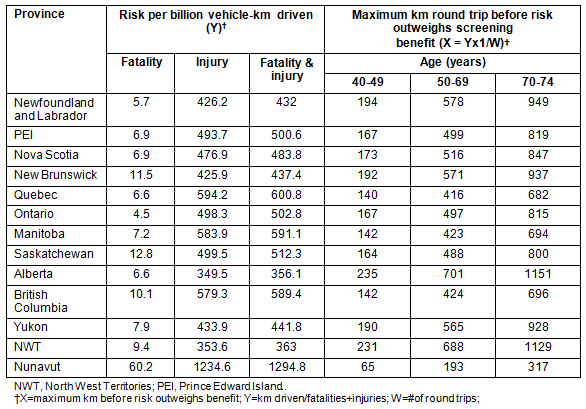Mammography is a controversial screening tool1-4. As with any screening program, the benefits of lives saved must be balanced against the risk of harm to the patient. One overlooked risk is the danger of travel to the screening site, particularly in large nations such as Canada. While the costs of travel in both accidents and dollar amount has been raised5, no literature was found that assessed the risk of injury or death from road travel and its effect on the risk-benefit profile of screening mammography. This article asks 'How far is too far?', before the risk of death or injury on the road outweighs the benefit of screening mammography.
The number of patients needed to screen and false positive rates for different age groups were taken from the screening mammography guidelines published by the Canadian Task Force on Preventive Health Care6. The motor vehicle accident (MVA) risk per kilometre driven was taken from the Transport Canada site7.
The authors were unable to find any data on the number of trips generated by a false positive mammogram. As such, screening mammograms of women who turned 50 years between 1 January 1995 and 1 January 2008 at Southwest Middlesex Health Centre were reviewed to deduce how many trips were generated by a false positive mammogram. A false positive mammogram was defined as any mammogram that recommended additional investigations which did not result in a cancer diagnosis. This was then added to the total number of trips women were to take if they chose to undergo screening mammography.
A formula was devised by the authors to determine when the risks of round trip to a screening site outweighed the benefits of screening mammography.
Ethics approval
The study was approved by the Office of Research Ethics, Western University, London, ON, Canada (#17946E) on 21 March 2011.
According to the Canadian Task Force on Preventive Health Care, the number needed to screen for mammography over 11 years is 2108 for women aged 40-49 years, with a false positive rate of 32.9%, 720 for women aged 50-69 with a false positive rate of 28 %, and 450 for women aged 70-74 with a false positive rate of 21%6.
Mammograms of women who turned 50 years between 1 January 1995 and 1 January 2008 were reviewed to determine a false positive rate. Of 234 women who had mammograms, 99 had a false positive. A false positive mammogram resulted in an average of 2.12 extra trips, which was rounded off to 2 extra trips for the purposes of calculation.
The formula for estimating the maximum distance travelled before the benefit of mammography is outweighed by the danger of road travel is:
| X | = maximum number of km driven/trip before risk outweighs benefit |
| Y | = 109 km driven/fatalities+injuries |
| W | = number of trips needed to save one woman's life by screening mammography (see Table 1) |
| X | = Y x 1/W |
The estimated number of trips necessary to save one woman's life from screening mammography is given (Table 1).
The maximum kilometres round-trip to a screening centre to benefit from screening mammography is estimated (Table 2) for each Canadian province and territory.
Table 1: Estimation of trips necessary to save one woman's life

Table 2: Maximum round trip distance before MVA Risk outweighs
benefit of mammography. Adapted from Transport Canada data7

Discussion
The distance a woman must travel to a screening site represents a risk of injury or death that may outweigh the benefit from screening mammography. This distance will vary depending on age and province, from 65 km for a 40 year old in Nunavut to 1151 km for a 70 year old in Alberta.
The risk of travel may be reduced by choosing not to travel in winter or only in day light hours. The risk differs depending on a woman's place of residence. Women who live far from screening centres need to be cognizant of the travel risks they are taking. Mobile mammography units would greatly reduce this risk.
This analysis is limited because MVA statistics pertain to the general population and not only to women in the age range of the screened populations. Gravity of injuries was not recorded in the government data.
Weaknesses of the study include that MVA statistics are for the general population and may differ for middle-aged women and for the time of day and season they travel. The number of trips generated by a false positive mammogram was determined by examining patient experience at our clinic and may not reflect the experience nationally or internationally.
The distance a woman must travel to receive screening mammography changes the risk-benefit profile of the test. This risk should inform a woman's decision to participate in screening. Women who reside far from a screening site would be well advised to travel when the risk of travel is lowest or to arrange screening when a trip is already planned.
References
1. McPherson K. Should we screen for breast cancer? BMJ 2010; 341: 233-235.
2. Welch HG. Screening mammography-a long run for a short slide. New England Journal of Medicine 2010; 363(13): 1276-1278.
3. Baines CJ. Frank words about breast screening. Open Medicine 5(3). (Online) 2011. Available: www.openmedicine.ca (Accessed 8 November 2012).
4. Gotzsche PC. Time to stop mammography screening. Canadian Medical Association Journal 2011; 183(17): 1957-1958.
5. McRae S. Screening Mammography. Canadian Journal of Rural Medicine 2010; 15(4): 167.
6. Fitzpatrick-Lewis D, Hodgson N, Ciliska D, Peirson L, Gauld M, Yun Liu Y. Canada Breast Cancer Screening. (Online) 2011. Hamilton, ON: McMaster University. Available: http://canadiantaskforce.ca/wp-content/uploads/2012/09/Systematic-review.pdf (Accessed 28 October 2012).
7. Transport Canada. Canadian motor vehicle traffic collision statistics. (Online) 2008. Available: http://www.tc.gc.ca/eng/roadsafety/tp-tp3322-2008-1144.htm (Accessed 13 December 2012).


